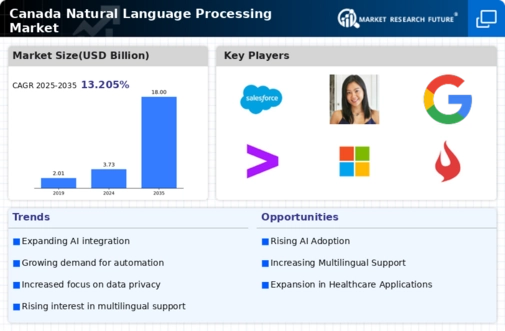The natural language-processing market is currently characterized by intense competition and rapid innovation, driven by advancements in artificial intelligence (AI) and machine learning technologies. Major players such as Google (US), Microsoft (US), and IBM (US) are at the forefront, leveraging their extensive resources to enhance their product offerings and expand their market presence. Google (US) focuses on integrating AI capabilities into its existing platforms, while Microsoft (US) emphasizes partnerships and acquisitions to bolster its cloud-based NLP solutions. IBM (US), on the other hand, is concentrating on enterprise solutions, tailoring its offerings to meet the specific needs of various industries. Collectively, these strategies contribute to a dynamic competitive environment, where innovation and adaptability are paramount.
In terms of business tactics, companies are increasingly localizing their operations to better serve regional markets, optimizing supply chains to enhance efficiency. The competitive structure of the market appears moderately fragmented, with a mix of established players and emerging startups. This fragmentation allows for diverse approaches to NLP applications, fostering a rich ecosystem of solutions that cater to different customer needs. The influence of key players is substantial, as they set industry standards and drive technological advancements.
In October 2025, Google (US) announced the launch of its new AI-driven language model, which aims to improve contextual understanding in real-time applications. This strategic move is significant as it positions Google (US) to capture a larger share of the market by enhancing user experience and engagement across its platforms. The introduction of this model is likely to set a new benchmark for NLP capabilities, compelling competitors to innovate further.
In September 2025, Microsoft (US) expanded its partnership with a leading Canadian tech firm to develop customized NLP solutions for the healthcare sector. This collaboration underscores Microsoft's commitment to addressing industry-specific challenges and demonstrates its strategy of leveraging local expertise to enhance its offerings. Such partnerships may facilitate quicker adoption of NLP technologies in critical sectors, thereby driving growth.
In August 2025, IBM (US) unveiled a new suite of NLP tools designed for financial services, focusing on compliance and risk management. This initiative reflects IBM's strategic intent to cater to highly regulated industries, where NLP can provide significant value by automating processes and ensuring adherence to regulations. The move is indicative of a broader trend where companies are tailoring their solutions to meet the unique demands of specific sectors.
As of November 2025, the competitive landscape is increasingly shaped by trends such as digitalization, sustainability, and the integration of AI across various applications. Strategic alliances are becoming more prevalent, as companies recognize the need to collaborate to enhance their technological capabilities and market reach. Looking ahead, competitive differentiation is likely to evolve, with a shift from price-based competition to a focus on innovation, technology, and supply chain reliability. This transition suggests that companies will need to invest in R&D and forge strategic partnerships to maintain a competitive edge in the rapidly evolving natural language-processing market.






















Leave a Comment